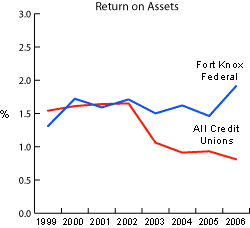Credit unions have long used the Return on Assets (ROA) ratio as a key performance benchmark. First quarter data shows the industry average ROA declining to 0.81%. As the only source of capital growth for credit unions, it is crucial that they analyzethe reasons why ROA continues to decline and what can be done to reverse this movement.
Key Trends Factor into Declining ROA

- Industry wide, rising interest rates and a growing loan portfolio led to increased interest income, which grew 13.1% to $9.13B.
- Non-interest income rose 10.7% from the first quarter of 2005 to $2.23B.
- As credit unions expand products offered to members and employee levels to serve them, first quarter operating expenses are up 8.3% versus the first quarter of 2005 to $5.75B.
- Increasing interest rates and growth in share certificate balances lead to a jump in interest expense, which rose 42.6% to $3.55B.
As a result of these four trends, net income decreased 7.6% to $1.43B for all credit unions.
Taking Action: One Credit Union’s Strategy to Boost ROA
Fort Knox FCU’s ($504 million in Fort Knox, KY) strategy to deliver high ROA addresses the issue from the expense and revenue side. Recently, it reached an operating expense to average assets ratio of 2.74%, measurably below the industry averageof 3.2% at the end of the first quarter.
Its success in maintaining high ROA via expense management begins in the product design phase. For example, it balances what the members want/need with its own financial objectives. A great example of Fort Knox FCU using this strategy is guiding members toward e-statements.
Fort Knox FCU made the decision to require e-statements as a condition to receive their home banking solution. We knew members wanted home banking and that we wanted to reduce statement processing costs, so we combined the two, saidCFO, Ramona Buchanan. Employees were then provided with a $2 per account incentive for converting members to online banking. The credit union recouped the employee incentive in saving the costs of three statement mailings. Should members wishto both obtain an electronic statement and a paper copy, there is a fee of $1.00 per month .
This tactic accomplishes two things: it reduces costs by providing balances via the internet rather than spending money on printing or mailing costs, and it generates income that covers the production costs for the credit union should the member wishto obtain a hard copy.
We try to operate under a win-win-win philosophy, said Buchanan. If a business decision is a win for our members, employees, and the credit union itself, better member services result, which will lead to better financial performance.Everyone wins.
This philosophy ultimately led them to a higher ROA with which they could provide more to their members. Fort Knox FCU has not raised rates on any loan within the Board’s control even though the Fed has raised rates 17 times. It is also maintainingcompetitive rates on savings including paying dividends on share drafts maintaining an average daily balance over $750 and offering free online bill pay. They have also introduced a new courtesy pay program.
These examples from Fort Knox FCU show how the old adage of working smarter, not harder can lead to a way out of the current ROA slump.
To learn more about how credit unions can overcome these tough interest rates and competitive environments, please join us for our webinar Overcoming the ROA Squeeze to Deliver Strong Bottom Line Results<ahref=”/events/webinars/webplate.asp?event=118″>.
